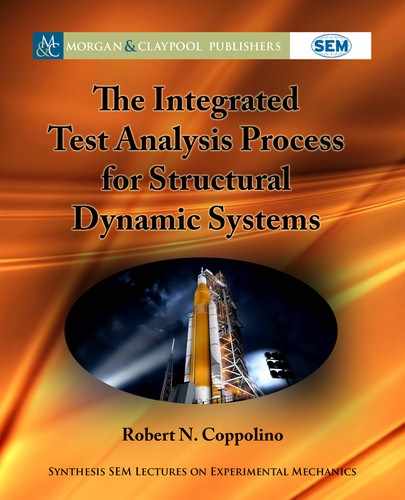
94 5. EXPERIMENTAL MODAL ANALYSIS
Complex eigenvalue analysis of the effective dynamic system produces the following re-
sults:
.a/
f
g
D
ˆ
f
q
g
; where the “left-handed” eigenvectors are
ˆ
L
D
ˆ
1
;
.b/
ˆ
L
ˆ
D
Œ
I
;
ˆ
L
A
ˆ
D
Œ
(complex eigenvalues);
.c/
ˆ
L
D
Œ
(modal gains); and
.d / Pq
j
j
q
j
D
.
/
j
Œ
F .f /
(frequency response of individual modes):
(5.18)
Recovery of experimental modes in terms of the physical DOFs involves back transfor-
mation employing the trial vector matrix, ŒV , specifically,
Œ
ˆ
D
Œ
V
ˆ
;
Œ
ˆ
L
D
ˆ
L
V
T
;
Œ
OR
D
Œ
ˆ
L
Œ
ˆ
Œ
I
: (5.19)
5.2.3 THE SFD METHOD PRIOR TO 2018
Estimation of the effective dynamic system with the SFD method (and more generally any
method that performs similar system “plant” estimation operations) will pick up spurious “noise”
degrees of freedom and associated spurious modes. Over the years since 1981, the writer has
employed a heuristic practice in versions of SFD algorithms that select “authentic” modes from
the complete set, which is estimated in selected frequency bands. e heuristic criteria include:
(1) elimination of modes having negative damping; (2) modes with very low modal gain; and
(3) other modes that appear spurious from any number of physical/experience based consider-
ations. Prior to 2018, the SFD method (this writer’s version) did not make use of the complex
modes associated with the effective dynamic system (Equations (5.15)–(5.19)).
e theoretical relationship between FRFs and modal parameters (assuming that modal
vectors are real) is
Œ
H.f /
D
Œ
ˆ
Œ
h.f /
; (5.20)
where
Œ
ˆ
is the unknown real modal matrix and
Œ
h.f /
is the SDOF acceleration FRF matrix.
e terms of
Œ
h.f /
are defined as
h
n
.f / D
.f =f
n
/
2
.
1 C2i
n
.f =f
n
/ .f =f
n
/
2
/
; (5.21)
where the f
n
and
n
are the modal frequency and damping associated with the particular exper-
imental mode. Since the modal SDOF acceleration matrix is completely known, the real modal
matrix is obtained by linear least squares analysis. At the experimental modal analyst’s discretion
(highly recommended), low- and/or high-frequency residual modal frequencies may be added
to the set of identified eigenvalues (the low-frequency residual FRF has a frequency close to “0”
..................Content has been hidden....................
You can't read the all page of ebook, please click here login for view all page.
